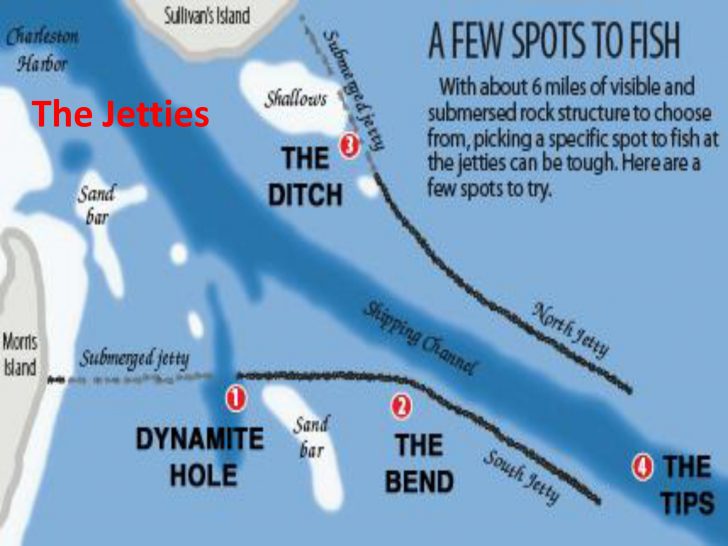David Fladd | April 2021
The Charleston jetties, built in the late 1800’s, are a set of immense stone walls running parallel to the harbor inlet. They funnel the tides and provide safe passage for the many commercial ships vital to the state’s economy.
They also provide incredible structure, and therefore, great fishing. In the warmer months, the jetties are a popular place to fish, and often boats are anchored all along the length of the rocks.
The most popular way to fish there is to cast out heavy “Carolina Rigs” consisting of a 3 to 6 oz weight followed by a couple feet of leader and a circle hook. Although this is a simple and productive way to fish them, I’d like to focus on another way to fish the jetties – with artificial lures.
Before you plan a trip out there, make sure you know what you’re getting into.
To get to the jetties you need to cross some rough waters that are always choppy and usually include swell. You need a seaworthy boat of at least 18 ft, in my opinion.
Before you plan a trip out there, make sure you know what you’re getting into.
There is a lot of water flow there. Three rivers, plus the harbor, at a depth of 5 to 6 ft, must flow in and out of the jetties every 6 hours.
That is a lot of water. Ocean liners and the pilot boats that service them are at work and are not paying attention to you in your fishing boat. When an ocean liner passes an immense amount of water sucks out of the rocks and like a tsunami, returns with equal force.
Large wakes several feet high are common. You really need to think about your safety and keep your head on a swivel. I have personally had some scary near-misses out there that still haunt my dreams on occasion.
If you’re thinking I’m trying to scare you, then, mission accomplished. Please respect the jetties at all times.
So, let’s talk about fishing the jetties. What can we expect to catch? Because the jetties extend a couple miles into the ocean, you literally never know what you might catch out there.
Red Drum, Spotted Seatrout, Flounder, Sheepshead, Spanish Mackerel, Crevalle Jacks, King Mackerel, and even Tarpon are some of the many possibilities.
Your most probable catch will be Red Drum a.k.a redfish. Thanks to our state having an upper slot for redfish, we have an incredible population of “bulls”. Some of these can measure up to 50” and they frequent the jetties.
Fishing the jetties with artificial lures is a blast.
You are going to need a trolling motor with spot-lock technology. The basic idea is you keep a casting distance away from the rocks and cast toward the visible rocks. Slowly hop the lure down the slope of the rocks.
As always, its imperative that you keep in contact with your lure so you can feel the sometimes-subtle bite.
Work the gaps in the rocks and different depths, then move along until you have a new section to cast to. This method can be difficult on a summer weekend because the bait soakers are blocking access. For that reason, I’d advise you to avoid trying it during those times.
Although it is always fun when your rod doubles over when soaking bait, I promise you its way more fun to feel the fish thump your lure while you’re working it down the slope. And, like I mentioned before, you just never know what you’re gonna get.
I’d like to recap a recent outing that is pretty typical of what you can expect. This winter I asked my friend Ty Kotz if he’d like to join me for a trip to fish the jetties with lures.
I’m still trying to learn the jetties and Ty is the perfect companion for scouting around because he’s just happy to be out fishing. Plus, we’ve only fished together a couple times and I consider him a good luck charm because we have always had epic days together.
I warned him before the trip that I had no idea if we’d be successful, and he was okay with that. So, we worked long stretches of the rocks just to see what would happen.
We started out working slowly throwing Texas Eye jigs with Z-Man Scented JerkshadZ. We didn’t have a single bite for 100 yards or so, then Ty picked up a couple decent trout.
Moving a little further, we picked up a slot redfish.
I have found that the fish seem to be concentrated in 100 ft or so lengths depending on the current and tide. That day, though, the fish seemed to be pretty random. It seemed like we would pick one up every so often – just enough to keep it interesting.
After the tide changed, we tried the other jetty and eventually stumbled on a pretty good redfish bite. We found a particular rock that held several nice fish and we even had a double at one point.
Steadily running the trolling motor and casting at random places, I suddenly got a big thump. I set the hook and I could immediately tell from the low-frequency headshakes that this was a giant.
First thing I said was “Uh-Oh!” I don’t think the beast knew it was hooked because it just set there for a minute. I high-sticked my rod and said “Ty, look, I’m not hung up…watch…” As we watched my rod tip it eventually made a long bob and we both started laughing. Did I mention this was on a trout rod with 10 lb braid?
I worked the trolling motor out to deep water and eventually she showed herself. After an excellent job by Ty with the lip grippers we carefully hoisted her into the boat.
She measured out at 40 inches and after applying a SCDNR dart tag, I revived and released her back to be caught again.

_____________________________________
This is exactly the kind of thing that makes fishing the jetties so fun. You never know what you might get, but even if you don’t hook a giant redfish, you almost always have action and often at least one of your catches will be a surprise.
Give it a try, but remember to pick your days, wear a PFD, keep your head on a swivel and bring a good luck charm like Ty.
Please consider letting the big fish go, even if its legal to keep them, and always support bull reds by the belly, not by the lip!
See you on the water!
David Fladd
Partner, Eye Strike Fishing
dfladd@eyestrikefishing.com
eyestrikefishing.com
You may also enjoy reading







